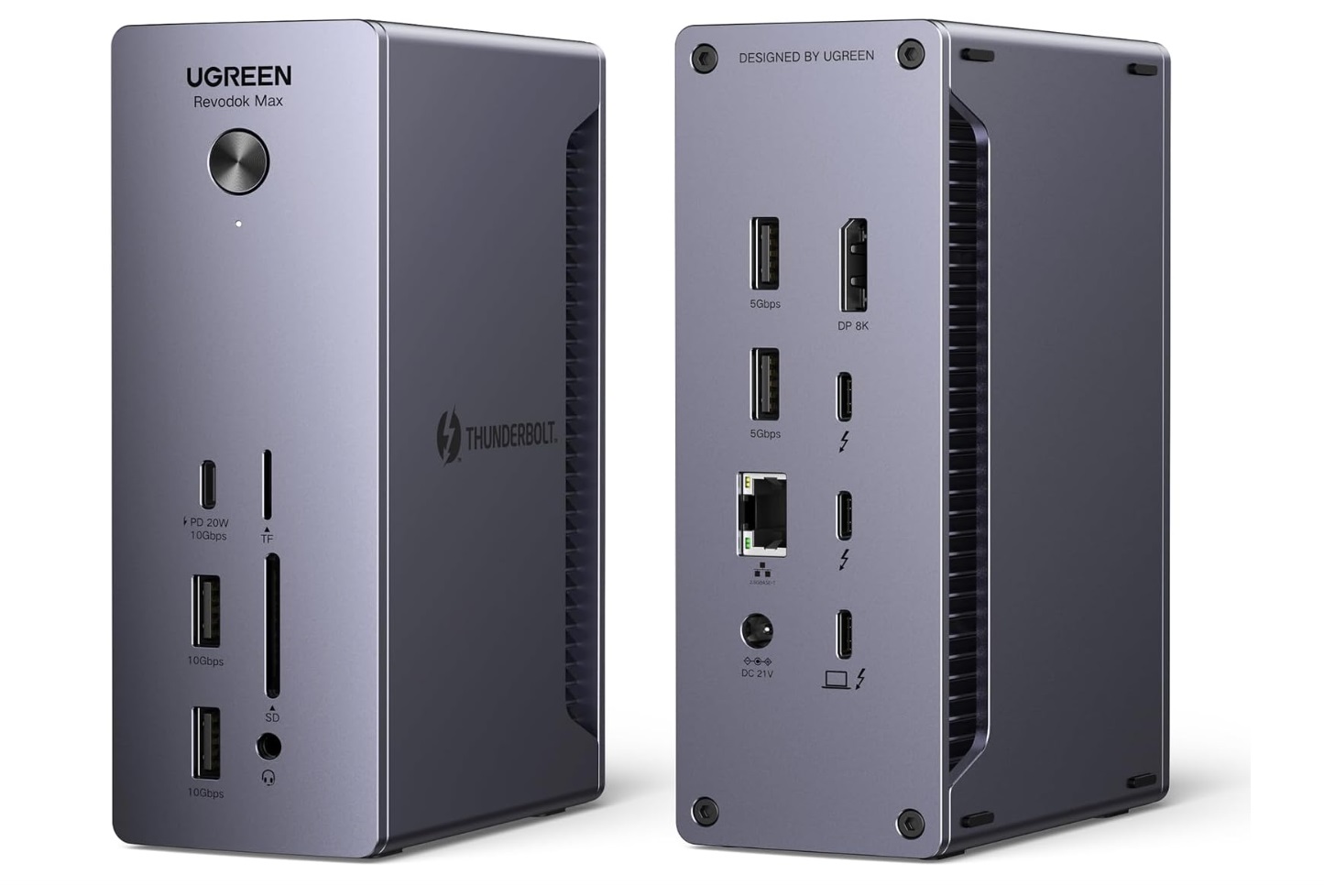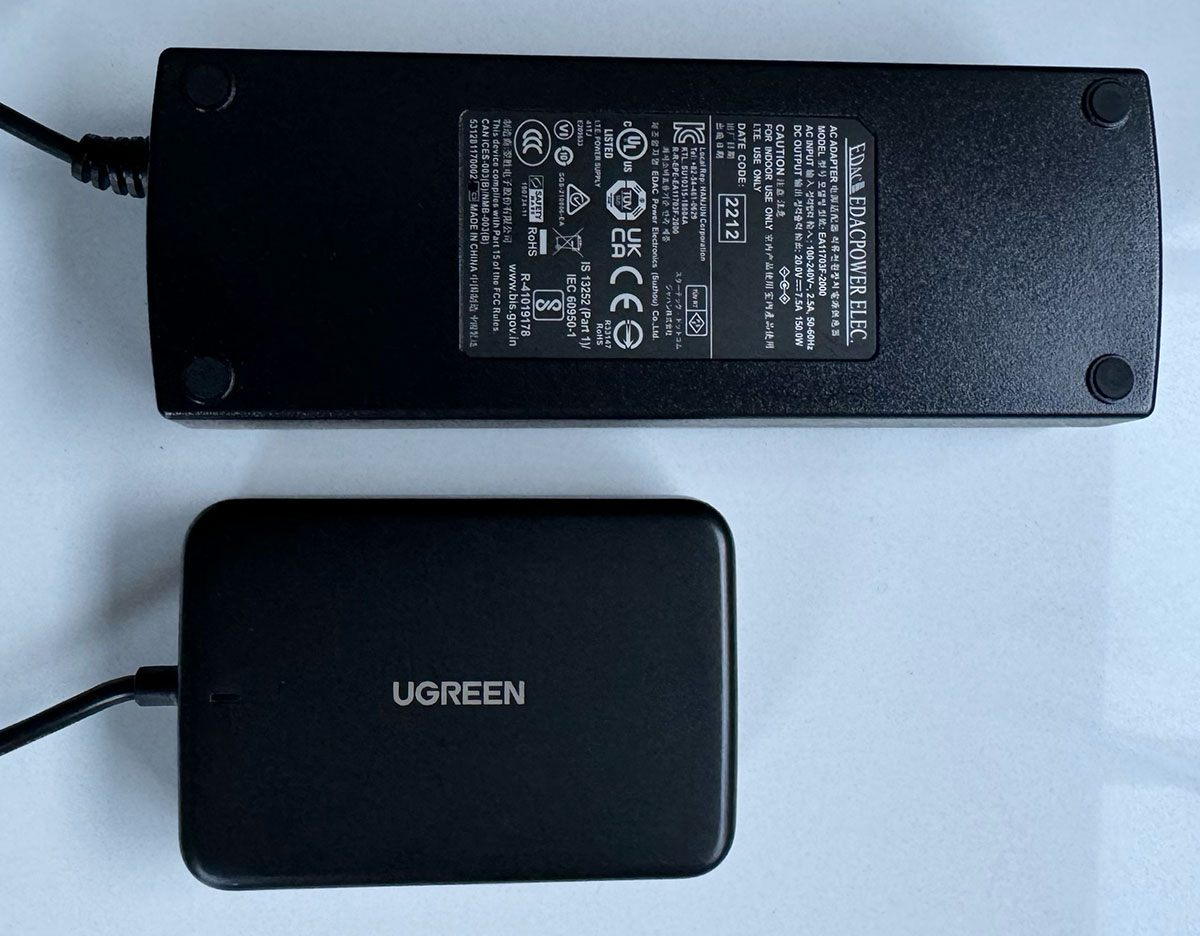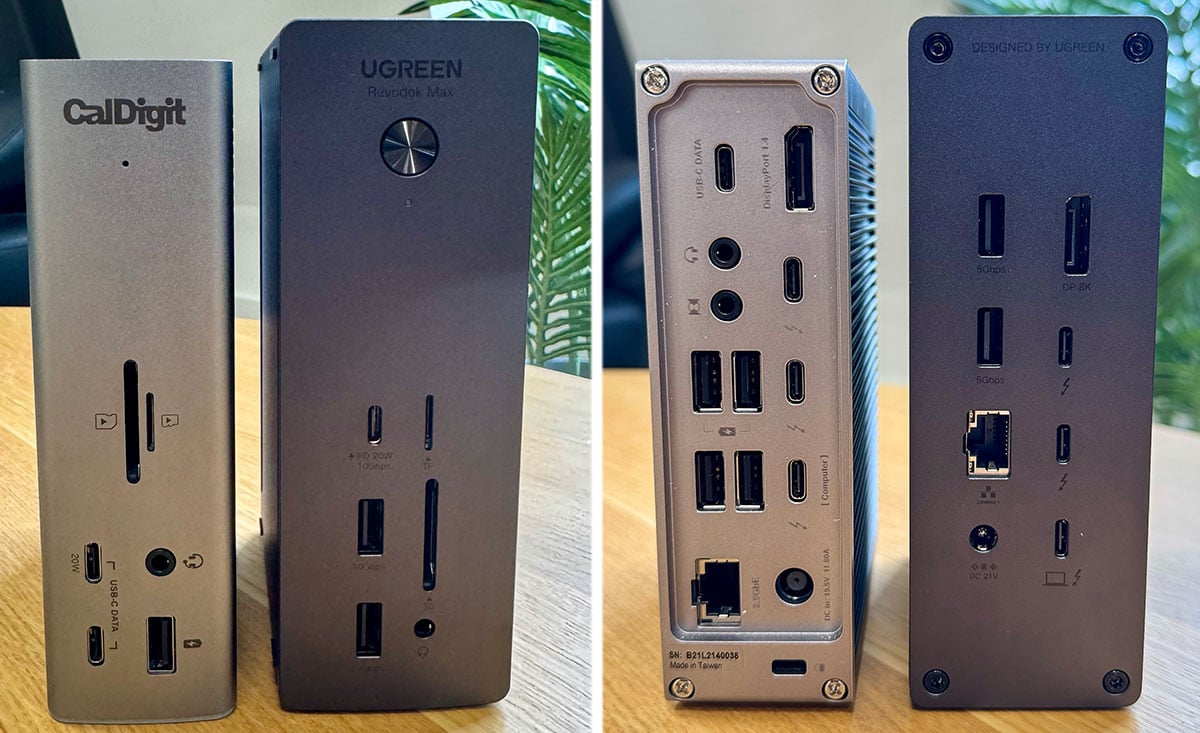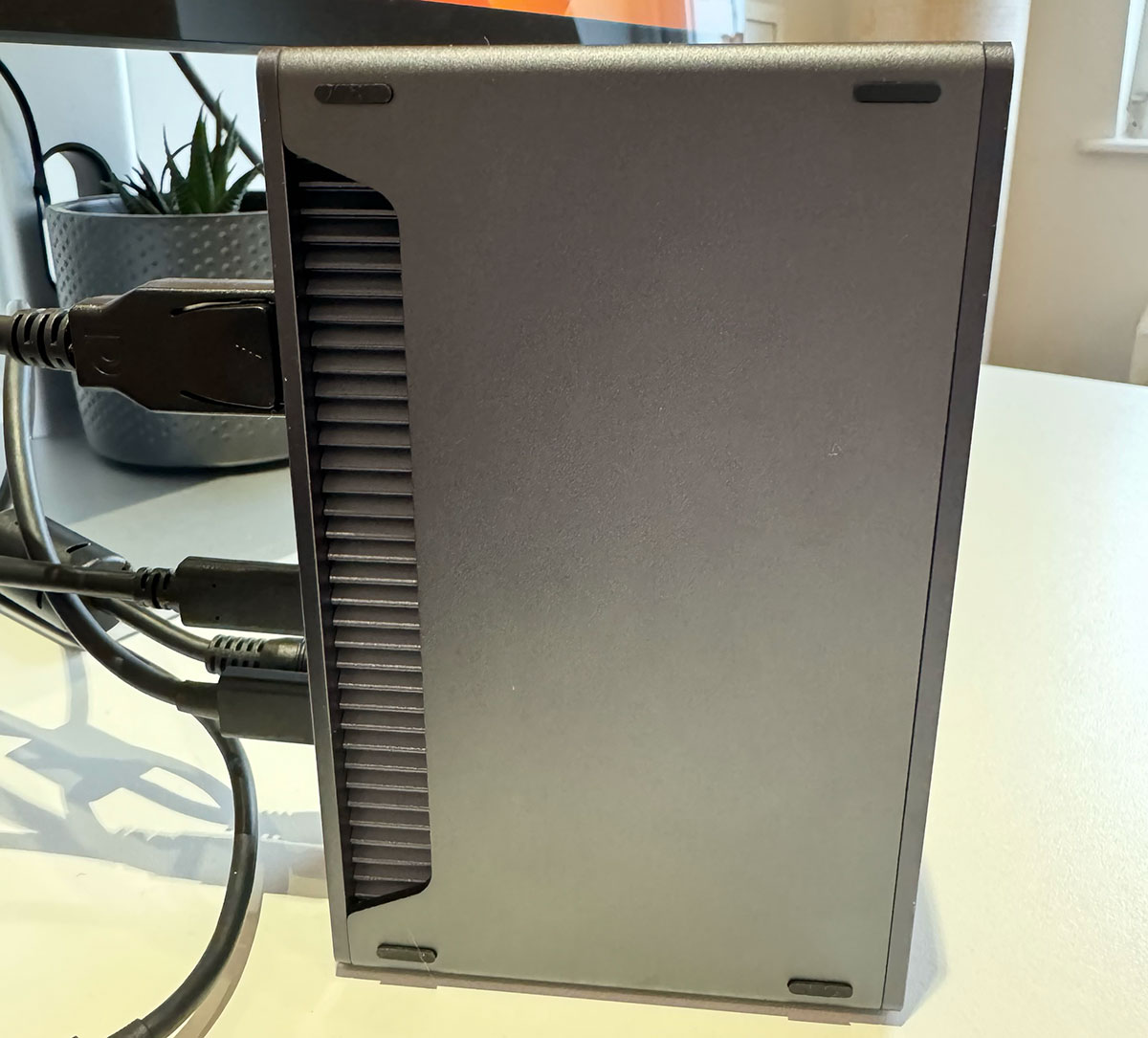Expert’s Rating
Pros
- 13 top-end ports
- Thunderbolt 4
- 2.5Gb Ethernet
- Dedicated DisplayPort 1.4 port
- 90W PD on 180W power supply
Cons
- Only one USB-C port
- Expensive
Our Verdict
The solid, compact 13-in-1 Ugreen Revodok Max 213 docking station looks great and offers all the ports most people will need—at a high price.
Looking like an integral part of a Stealth Bomber, Ugreen’s gunmetal gray Revodok Max 213 Thunderbolt Dock is a mean-looking desktop accessory. Built for a vertical orientation, it resembles the mighty CalDigit TS4 Docking Station and is priced accordingly. We’ll compare the two docks, plus a third contender, later in this review.
The Revodok Max 213 has an impressive range of high-end ports, starting with its Thunderbolt 4 connection to your MacBook, two more TB4 ports and a dedicated DisplayPort 1.4 port to connect your main monitor. It can support two 4K displays at 60Hz, and boasts super-fast 2.5Gb Ethernet.

Ugreen / Amazon
Specs and features
The Ugreen Revodok Max 213 Thunderbolt Dock has 13 top-end ports.
- One upstream Thunderbolt 4 port (40Gbps, 90W PD)
- Two downstream Thunderbolt 4 ports (40Gbps, 15W)
- One DisplayPort 1.4 video port (2x 4K at 60Hz)
- Two USB-A ports (10Gbps, 7.5W)
- Two USB-A ports (5Gbps, 7.5W)
- One USB-C port (10Gbps, 20W)
- 2.5 Gigabit Ethernet
- UHS-II SD card reader (312MBps)
- UHS-II MicroSD card reader (312MBps)
- 3.5mm combo audio jack (front)
- 180W power supply
While the Revodok Max 213 has a strong range of ports, you can find docking stations with more: the Sonnet Echo 20 SuperDock has 19, including an internal SSD slot. The CalDigit TS4 Dock has 18.
Most of those extra ports on the Echo and TS4 are spare USB and multiple audio ports; the Revodok 213 is a little sparse on USB-C, with just a single port—although that one can charge a connected device at 20W, matching the TS4’s front-mounted USB-C and beating the Echo’s 7.5W USB-C ports.
In comparison, the TS4 has three 10Gbps USB-C ports (one at 20W). The Echo has four, although all at 7.5W. Ugreen has more USB-A ports: two at 10Gbps and two at 5Gbps.
Of course, all three docks also provide two downstream Type-C-compatible 40Gbps Thunderbolt 4 ports; each at 15W charging potential. The Revodok’s 180W power supply is superior to the Echo’s 150W but no match for the TS4’s 230W supply.

Foundry
The Revodok Max 213 can charge a laptop at up to 90W, a little weaker than the Echo (100W) or TS4 (98W).
As shown above, the dock’s power supply is super-compact. Ugreen makes some of our favorite tiny Mac laptop chargers, and has clearly used some of its charger engineering chops to great effect here.
It lets you daisy-chain up to six Thunderbolt devices via the two downstream Thunderbolt 4 ports—note that these connected devices will share the 40Gbps bandwidth upstream to the laptop. You can add affordable portable storage via both the SD and MicroSD 4.0 card readers, both of which are at speedy 312Mbps UHS-II. You can usually buy a quality 512GB card for around $30/£40, although storage prices can be volatile so may change.
If you’re lucky enough to be connected to a super-fast wired network, the 2.5 Gigabit Ethernet port puts most other docks to shame. It is backward compatible with other speeds of Ethernet, so it’ll work with a standard Gigabit Ethernet network. You can connect wired headphones or a microphone via the front-mounted 3.5mm audio jack.
If you have legacy A/V equipment with RCA jacks, you should consider the Echo 20’s two back-positioned right and left channel line out RCA jacks. The TS4 has 3.5mm jacks both front and back, so speaker cables would be tidier if connected to the back port.
Display support
Rather than host the possible three downstream TB4 ports, each dock compared here swaps one for a dedicated video port: the Revodok and TS4 go DisplayPort 1.4, while the Echo has an HDMI 2.1 port.
These video options are close in capabilities, but if your monitor requires HDMI, you’ll need a DisplayPort to HDMI cable with the Ugreen or TS4 docks. The real potential of that DisplayPort port is Windows support for a single 8K monitor at 30Hz, but sadly Apple display limitations mean the highest Revodok-linked display resolution possible is 4K at 60Hz.
In comparison, the TS4 and an M-Series Mac can support a single 6K display at 60Hz or 4K at 144Hz but it’s also restricted to 4K at 60Hz when connecting dual displays.
You can connect another screen via one of the Thunderbolt ports, or two via both the downstream Thunderbolt ports—although utilizing that DisplayPort makes more sense for one screen. Using Thunderbolt, you’ll need either a USB-C monitor or an adapter cable.

Foundry
Design
This Ugreen Revodok Max 213 docking station looks a lot like the CalDigit TS4. Both can lie horizontally or stand vertical to save on desk space. There are small rubber feet on one side and the vertical bottom.
Full marks to Ugreen for positioning the upstream Thunderbolt 4 port at the back, unlike many docks that place it messily at the front. To be fair to its closest rivals, both the Echo 20 and TS4 also put the host connector at the back.
One thing I like to see on a dock is a power button, so I can quickly stop the constant battery charging when I’m away from the laptop overnight. Neither the TS4 nor Echo 20 has an On/Off button.
If color means a lot to you, the three docks we’ve compared here offer you choices: the Ugreen in a cool-looking Gunmetal Gray, Sonnet in Black, and CalDigit in Aluminum.

Foundry
Price
The Ugreen Revodok Max 213 docking station costs a rather steep $400/£400, which matches the CalDigit TS4’s price and other Thunderbolt 4 docks such as Kensington’s SD5700T ($370). The Sonnet Echo 20 Thunderbolt 4 SuperDock is $100 less at $300. (In the U.K. prices are consistent at the high end, so U.S. customers can pick up a bargain with the Echo 20.)
For the extra $100, we do prefer the Ugreen and CalDigit docks for looks over the Sonnet but remember that the Echo 20 also offers a built-in NVMe SSD slot so you can add storage right within the dock, although the SSD card itself isn’t included in that price.
Verdict
The solid, compact 13-in-1 Ugreen Revodok Max 213 docking station looks great and offers all the ports most people will need. It’s up against some serious competition, however, and its price is therefore under the microscope when comparing it to rivals such as the CalDigit TS4 and Sonnet Echo 20. Read our roundup of the best docking stations for Mac for further buying advice.
If you want to connect to a single 6K display, the TS4 offers that higher resolution, and also a single 4K at 144Hz refresh rate. Both are matched when it comes to a two external displays setup.
If you can afford it, the Revodok Max 213 is a great and able dock that you’ll be proud to have on your desk.
